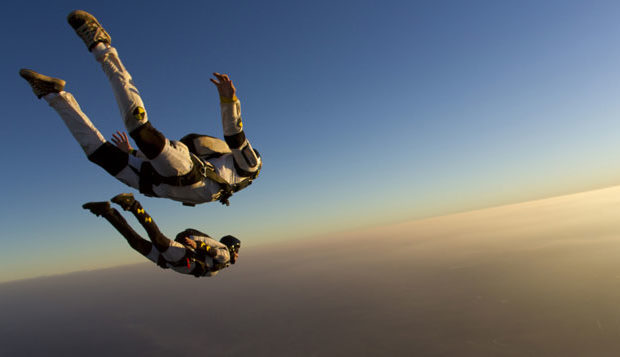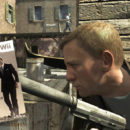EXTREME 007 -- If you see how often James Bond gets thrown from an airplane, you might wonder if he ever considered skydiving training! Let's discuss what you need to know to prep for skydiving!
"He didn't even say, "Goodbye!" If you see how often James Bond gets thrown from an airplane, you might wonder if he ever considered actual skydiving training! But other films, like The Living Daylights, shows that Bond knows what he's doing. Let's discuss what you need to know to prep for your first time skydiving!
What is skydiving, and why do people do it?
So without any flourish, what exactly is skydiving? Skydiving is a sport where people, either solo or in groups, wear parachutes and jump out of an aircraft -- usually between 3,500 and 13,500 feet above the ground (AGL). After spending a certain amount of time in free fall and hopefully accomplishing what they set out to do (about sixty seconds from 13,000 feet), they deploy their parachutes and return safely to the ground. While it’s true that your first jump will be little more than falling straight down, once you develop some basic air skills, you can literally learn to fly your body in the sky and pull off some heart pounding, amazing things on your own or in a group.
Of course, if you haven’t made up your mind to actually go on a jump, you’re undoubtedly wondering why you would ever want to risk life and limb to do such a thing. You’re wondering what on Earth would ever possess someone to jump out of a perfectly good airplane.
The answer to that question differs with every jumper. A lot of people simply make one jump because it’s on their bucket list. Others love the idea of being able to fly like a bird, or they just enjoy the challenge. Some use it as a method for personal growth or empowerment. Some love the adrenaline rush. The reasons go on and on. But there’s one thing that’s a constant for everyone: the sport is addicting (some call it legal crack), and it has forever changed both their lives and the way they see the world.
Isn’t skydiving dangerous?
You’ve probably had that thought multiple times, and chances are, it comes either right before or after, I can’t believe I’m even remotely considering this. The answer is, yes it’s dangerous. You’re hurling yourself at the ground at 120 mph and trusting a bunch of fabric to slow you down enough so you don’t turn into a pancake. If you don’t think that’s dangerous, then do every skydiver a favor and don’t get in the air. No one wants to be taken out by some idiot that doesn’t respect the sport.
Now before you run for the hills and scream, “I knew it! You’ll never get me to jump!” consider this: The world is dangerous. Aside from natural things like fires, floods, disease, etc. that can take anyone out without warning, we do things all the time that are downright crazy (and deadly). We zip along highways at sixty, seventy, eighty miles per hour in multi-ton vehicles without a second thought. We shoot across the country in jets without batting an eye. We swim in water that has all sorts of things that would love to take a bite out of us. And if you really want to put some hard facts to it, you’ve got a better chance of dying in a car wreck, cycling, running, or swimming than you do making a jump. Believe it or not, even tennis is only marginally safer (compiled statistics available at: http://www.medicine.ox.ac.uk/bandolier/booth/risk/sports.html).
So, in short, while the sport is dangerous – especially if not respected – it is actually less dangerous than things you likely already do every day without a second thought. The only reason you think skydiving is insane is because it’s a sport that’s completely alien to you. And that’s okay. It’s normal.
What should I wear?
No matter what sort of jump you are doing, be it your first or your thousandth, always wear something that you’re comfortable in and don’t mind getting dirty. On a hot day, you might want to wear shorts and a t-shirt, or if it’s cold outside, pants and a long-sleeve shirt would be fine as well. So men, leave the tailored suit at home, and ladies, even if that outfit looks really cute and does a fantastic job of slenderizing your hips, unless you’re okay with the possibility of it being torn, ripped, or soaked, leave it in the closet. While 99.99% of landings are uneventful, they aren’t always stand-ups (that is, landing on your feet as opposed to hitting the ground and falling over). Even the most seasoned pro has to butt-slide one in from time to time. Those landings don’t hurt, but as you can imagine, they aren’t friendly on what you’re wearing either.
Lastly, on what to wear, remember this rule: Wear sneakers. Always. No boots. No sandals. No flip flops. No bare feet. And no heels. Wear sneakers, or…wear sneakers.
Do I need to be super-fit?
Like most things in life, the better overall health you are in, the better. Physically speaking, if you are anywhere near being height-weight appropriate and in good health, you should have no troubles whatsoever. Drop zones (also known as DZs) usually have weight limits due to a variety of things like who their instructors are, equipment fitting, etc. and the limits usually start around 240-250 pounds. If you happen to be over the limit, don’t fret. These aren’t hard numbers, and the drop zone can often work with you.
If you have any serious physical limitations or ailments, be sure to let the drop zone know. This is for everyone’s safety, and don’t be too quick to think that anything in particular will keep you from jumping. People who are amputees, paraplegics, quadriplegics, or even blind, have all successfully made – and enjoyed – numerous jumps. As long as you’re over eighteen years old and breathing, it’s worth seeing if they’ll take you up no matter how badly out of shape you may feel you are.
What will the actual jump like?
Succinctly? It will be the best thing you’ve ever done.
In terms of a more detailed answer, this is usually how it goes for most people: The first thing you want to do is find a DZ. At this point in the game, your only real concern should be whether or not they are a member of the United States Parachute Association (the USPA is available online at: http://www.uspa.org/). They are the organization that helps regulate and govern the sport in the United States. They also happen to be the same group that issues licenses to skydivers. If you are outside the United States, find out who the equivalent is for your country.
Once you have a DZ in mind, you’ll want to decide on what type of first dive you want to do, and there are three basic types from which to choose:
Tandem Skydive - This is the most popular first dive by far. You will be strapped to an expert instructor who has at a bare minimum, 500 jumps (and in reality, probably has thousands). This type of jump is the easiest to accomplish. There are only fifteen minutes of ground school needed before you go up in the air since all you really need to do is smile for the camera. Your instructor will ensure you land safely. As an added bonus, it’s also usually the cheapest, and should run you about $200.
Accelerated Free Fall (aka AFF) – If you go this route, you’ll get to do everything. After six to eight hours of ground school where they will teach you the ins and outs of skydiving, you will be required to check and put on your own equipment, jump out of the airplane, deploy your parachute, and safely land the canopy. If you’d rather be the driver rather than the passenger of a racecar, this is the way to do it. But don’t worry; you will be supervised the entire time. Aside from ground school, you will have two instructors that will fly next to you during freefall on the off chance you need a little assistance. Because of the added training required, and the fact that two instructors are going up with you instead of one, the cost is usually more than a tandem dive, and you can expect to pay about $300 for the first jump. Subsequent AFF jumps (to work on your license) go down considerably in cost.
Static line / IAD (Instructor Assisted Deployment) – Whereas AFF jumpers start learning to jump from about 13,000 feet, if you choose the Static line method, you’ll start learning from much lower altitudes as there is no free-fall component in the beginning. What you will do is jump out of the plane with a line attached so that once you are clear of the plane, your parachute immediately opens. There’s still a hefty ground school to go through since you still have to land your own canopy, but it’s an option that some people find appealing and some instructors swear by. Cost wise, you’re probably looking at something in between the Tandem and AFF options. Though it will vary from DZ to DZ, it will probably be around $250 for your first static line jump.
If you aren’t sure which method you’d like to use, or if you have questions, call the DZ and ask what they recommend. And speaking of calling the DZ, you’ll also want to call them to make an appointment for your first dive. Like any business, drop zones can get busy, so having a reservation can mean the difference between jumping within the hour you arrive, or sitting around waiting all day as those who made reservations get to go ahead of you.
Once you have your appointment, you’ll find your nerves mounting as Jump-day draws near. Even if you’re excited about skydiving, when you actually get to the DZ, you’ll find that you’re more nervous than you had expected to be. After all, you’re about to knock on the Reaper’s door and take off running before he can answer.
You might grow quiet. Most people do. You might talk a lot. You might pace about and avoid everyone. But one thing is for certain: all the veteran jumpers will smile and know firsthand exactly what you’re going through.
At some point, you’ll need to check in with manifest, as it’s generally a good idea to do that when you first arrive. Manifest is the office where the drop zone coordinates all of the jumps for the day. There you will be required to fill out paper work, and after that, they will send you off for some basic training.
About twenty minutes before your plane takes off, you will put on your equipment. For tandem students, this is simply slipping into a harness with straps that go over the shoulders, around the chest, and around each leg. Each harness has four clips to it as well, and these clips are what keep the student attached to the instructor. They may look small, but each one can hold two and a half tons. Yes, that means all four together could hold an elephant without coming close to breaking.
Aside from the harness, you will also be given a pair of goggles, and a helmet if you so desire. If you’re not doing a tandem jump, you will also put on your rig (that’s the backpack looking thing that holds your main and reserve parachutes) as well as an altimeter (which tells you how high you are and can be handy). As a purely optional thing, you can also put on a jumpsuit which is worn over the clothes you have on.
The plane will probably be packed with other eager and excited skydivers. Generally, it will take about ten to fifteen minutes for it to climb to altitude. Unfortunately, there will be no peanuts, refreshments, or in flight movies for you to enjoy. But the view from the windows is always nice. So relax as best you can and take a gander at everything you’re flying over. A few minutes before it’s time to jump, your instructor will do one final gear check and make sure that you are both good to go.
When the plane finishes its climb, it will level off, and you will hear a noticeable drop in pitch in its engines. At this point, you will be on what’s called “jump run.” Jump run is the portion of flight where the plane flies as slow as possible over the target area, and as the name suggests, skydivers jump out.
Jump run is also when some idiot will open the door to the plane, and that, my friend, is the moment where it all comes together. Cold wind will roar past your ears, and just a few feet away, where the door used to be, you’ll see the open sky above and the dark ground far below. Life will never seem more real than what’s going on in that very moment, and you’ll be convinced Death is next to you, smiling, maybe even tapping you on the shoulder. Before you’re ready, your instructor will bring you to the door and after a brief count of, “Ready! Set! Go!” you both will jump out.
Hands down, the hardest part of any first skydive is getting out the door. Once you do that, once you conquer that fear, the rest is pure bliss. It will be like a switch in your brain flips and you go from stark terror to pure elation. You’ll only have the sensation of falling for about a second or two, after which, you’ll be completely weightless. Wind will rush past your ever smiling face. And although on some level, you know you’re falling, it won’t look like it at all. From two and a half miles up, the human eye can’t tell that the ground is approaching. As such, your brain will (mostly) be convinced that you’re floating in air. But more importantly, you’ll love every minute of it.
At around 5,000 feet above the ground, you or your instructor will deploy the main parachute. It takes about three seconds for the chute to fully inflate, and for many people, those three seconds feel like a lifetime. But once it’s open, you’ll feel an upward snatch. After that, it’s usually a three to five minute canopy ride back to the ground, depending on what you want to do. Some people want to gently float down and take in the scenery, while others would rather whip around the sky like they were on a roller coaster. It’s up to you what sort of canopy ride you’d enjoy.
When you get back to Earth, you’ll have a story to tell for the rest of your life. You’ll also be grinning from ear-to-ear because your brain will be swimming in an Olympic-sized pool of endorphins -- and that’s a high you won’t come down from for a week. You’ll recount your experience to anyone and everyone that will listen with the fervor and excitement that only a madman could match. Most importantly of all, you’ll understand exactly why skydivers do what they do. From that day forth, whenever someone asks, “Why would you ever do that?” all you’ll be able to do is smile and say, “You’ve got to try it to really find out.”











Top 5 Rejected James Bond Theme Songs
The "No Time To Die" Review